 Sunday/Weekend
Sunday/Weekend

Trịnh Văn Binh and his troupe members, aged between 60 and 87, belong to Đục Khê Village, Hương Sơn Commune in Hà Nội’s suburban Mỹ Đức District. They have performed at many festivals in the northern region of the country and are much loved as the troupe of old dancers.
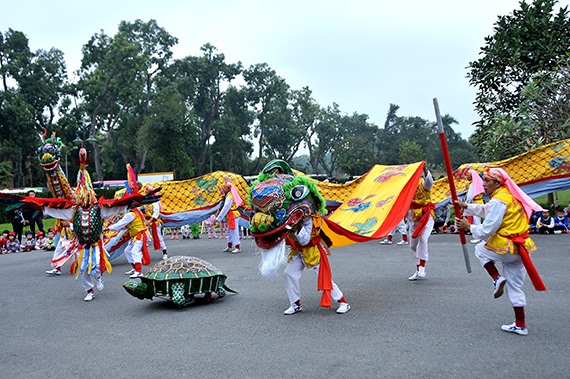 |
| Keeping culture alive: Despite old age, the elders from Mỹ Đức District still nurture a passion for the traditional dance. |
By Minh Thu
Despite his old age, Trịnh Văn Binh is graceful in controlling the dragon head leading his troupe in the tứ linh (four sacred mythical creatures: dragon, kylin, phoenix and tortoise) dance.
Seventy-year-old Binh and his troupe members, aged between 60 and 87, belong to Đục Khê Village, Hương Sơn Commune in Hà Nội’s suburban Mỹ Đức District. They have performed in many festivals in the northern region of the country and are well-known and impressive as the troupe of old dancers.
In Vietnamese belief, the four sacred mythical creatures - the dragon, the kylin, the tortoise and the phoenix - symbolise luck, longevity, prosperity and success. A traditional dance choreographed with the moves of these animals is an indispensable part of spring festivals.
The elderly members of the art troupe entertain their audience with an impressive performance and exciting music. In a large communal ground, villagers watch a 35m-long dragon, fashioned from a piece of red cloth, moving around under the control of the troupe members.
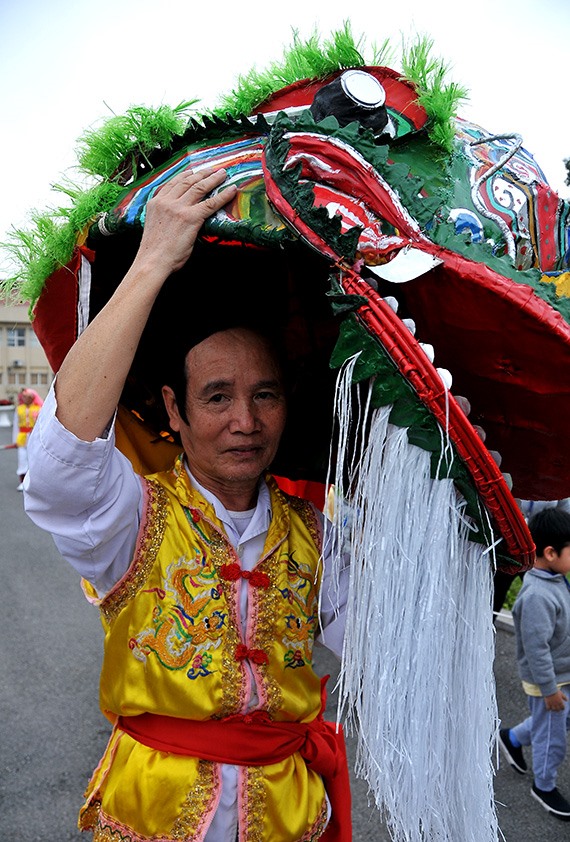 |
| Passionate: Though carrying the head of the dragon is very hard, Trịnh Văn Binh still loves practising and performing the dance. |
Next to the dragon, a kylin shakes its head, blinking its large eyes while moving around a club as if performing martial arts. A tortoise moves slowly, bobbing its head, while a phoenix spreads its beautiful feathers as if flying to the rhythm of the folk music.
The troupe of old dancers wowed the audience during the Lunar New Year celebrations organised at the former Thăng Long Imperial Citadel last month. This is the first time the dance has been featured in the public in its entirety.
Steeped in mythology
According to historian Lê Văn Lan, the four sacred, mythical creatures in Vietnamese culture. The dragon represents authority, the royal court, the king, the rain and the wind. The kylin symbolises power, while the tortoise is believed to bring prosperity to every family. The phoenix stands for nobility and is sometimes compared to the queen for its beauty.
Since ancient times, the shapes and movements of the four sacred animals have been featured in the dance of the Vietnamese people, performed during festivals to express gratitude to the gods and to pray for bumper crops and a peaceful and prosperous new year.
“The musicians who accompany the dancers play a very important role in the show,” says Lan. “All the dancers and musicians wear makeup and move the figures of the four sacred animals to make them appear to be dancing. The Lunar New Year festival is a prime occasion to perform this dance.”
The performance comprises a separate dance for each animal and a dance for all the four together. Each dance has its own meaning. For example, at the opening ceremony of the Hương (Perfume) Pagoda’s annual festival in Mỹ Đức District, the dance conveyed the meaning of taming the animals, particularly the fierce dragon and kylin, with the help of Buddhism.
Phạm Quý Sửu, 67, has been performing this dance for 20 years. He does not remember when the troupe was founded.
“When I was young, my father and uncles were members of the troupe. I and other villagers have tried to uphold the tradition,” he says.
Preserving tradition
The Four Sacred Animals Dance is one among several ancient dances performed in Thăng Long (former name of Hà Nội). Múa chạy cờ originating in Triều Khúc Village, Thanh Trì District, is performed in village festivities where amateur artists hold flags and dance and run to the boisterous sound of drums and castanets; Múa bồng is a cross-dressing double act dance performed at the Hào Nam Village festival; and in Múa lục cúng, the monks offer lamps, flowers and fruits to Buddha.
All these dances are exceptional art, born in the ancient Thăng Long Citadel. They have been and are being revived after a long time in oblivion.The dancers themselves cannot explain why the troupe consists of old dancers. One of the reasons may be only elderly people who have lived an untarnished life and are respected by the villagers are given the honour of holding the symbols of the four sacred creatures.
Sửu says the troupe has preserved the tradition and dancing style handed down from the previous generation.
“The four sacred animals show their respect to Buddha as they enter any pagoda or temple. In the dances performed in our commune, the kylin dance must involve a person excellent in martial arts to perform the dance with a club to control the animal,” he says.
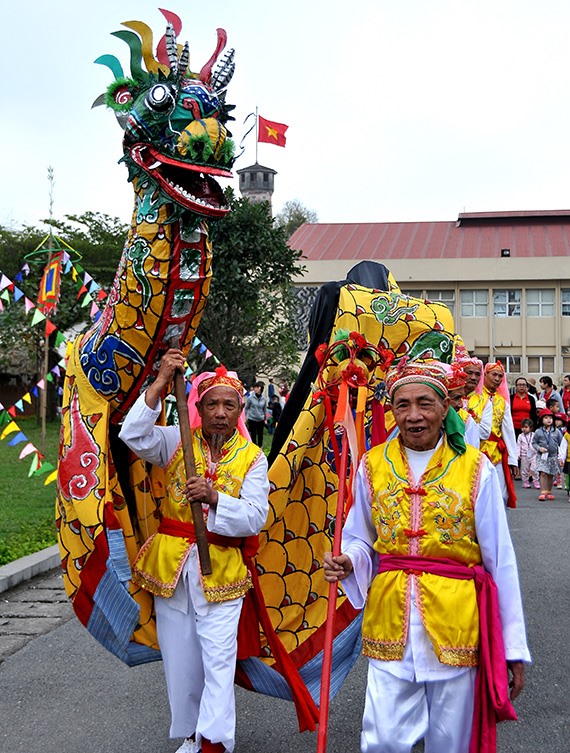 |
| Still going: The troupe of old men from Mỹ Đức District perform Four Sacred Animals dance at the Royal Citadel during the spring festival held last month. VNS Photo Thanh Thủy |
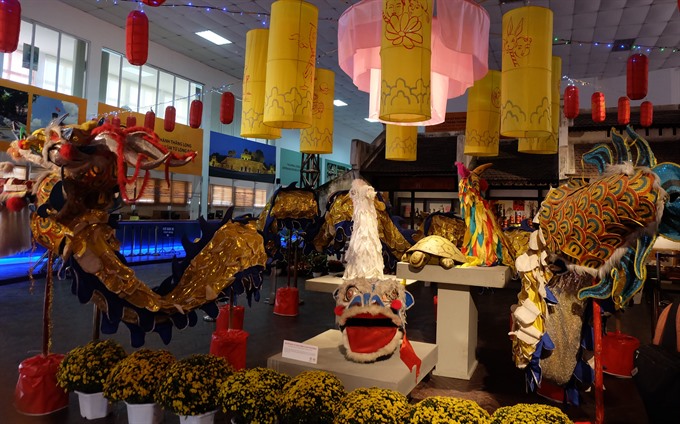 |
| On show: Items used in the Four Sacred Animals dance displayed at the Royal Citadel to introduce guests to the art. |
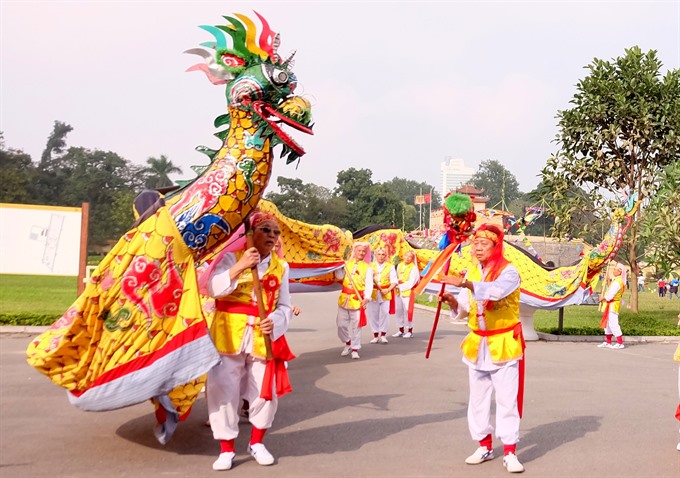 |
| Colourful: Despite old age, the elders from Mỹ Đức District still nurture the passion for a passion for the traditional dance. |
 |
| Make some noise: The Four Sacred Animals dance is accompanied by musical instruments, not singing. |
The dancers are also respected because they carry heavy props, such as the dragon head and phoenix costume.
In his troupe, Binh is in charge of holding the dragon head weighing 15-20kg, the heaviest part of the costume.
“Controlling the heavy dragon head is not easy because I have to lead the other dances. But I love it since it gives me a sense of freedom to lead the members and create beautiful movements,” Binh says.
He and other dancers are farmers. They work on the field when they are not performing. They exercise and practise the dance every day to keep good health. They are aware that good diet and frequent practice can help them improve their endurance.
“Our 25-strong group performs dances and plays music. We want to uphold the tradition of the nativeland despite our old age,” Binh says.
Beside dancing, all members of the troupe can also play musical instruments and fix the props.
"When a member is too old to dance, he can play music. We also make and repair the costume and props by ourselves because we know them well and can make it according to our convenience. Another reason why we have to make the props ourselves is that these are not available in the market,” Binh says.
Every year, young new members are recruited to the troupe to learn the art and become the next generation of dancers.
Phạm Văn Phương, 40, believes the uniqueness of the dance is its slow yet charming movements. He is new to the troupe and is learning how to control the props and dance.
“When we (new members) know the dance carefully, we will get a chance to join veteran dancers performing during festivals in the region,” he says.
The Four Sacred Animals Dance and its beautiful images and meanings have become an integral part of the Vietnamese spiritual life and of every New Year celebration. The old dancers are still enthusiastic about performing, with the aim to preserve the fine tradition of their homeland. Moreover, they agree that dancing helps them lead an active and meaningful life. VNS




.jpg)